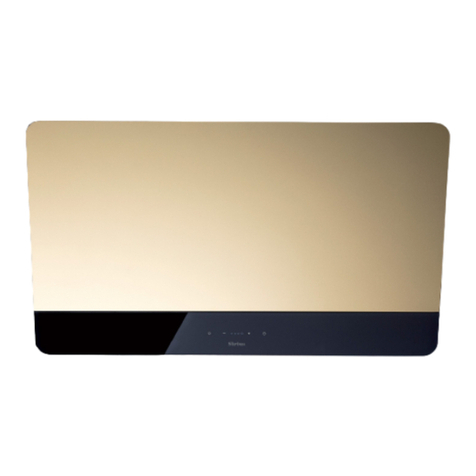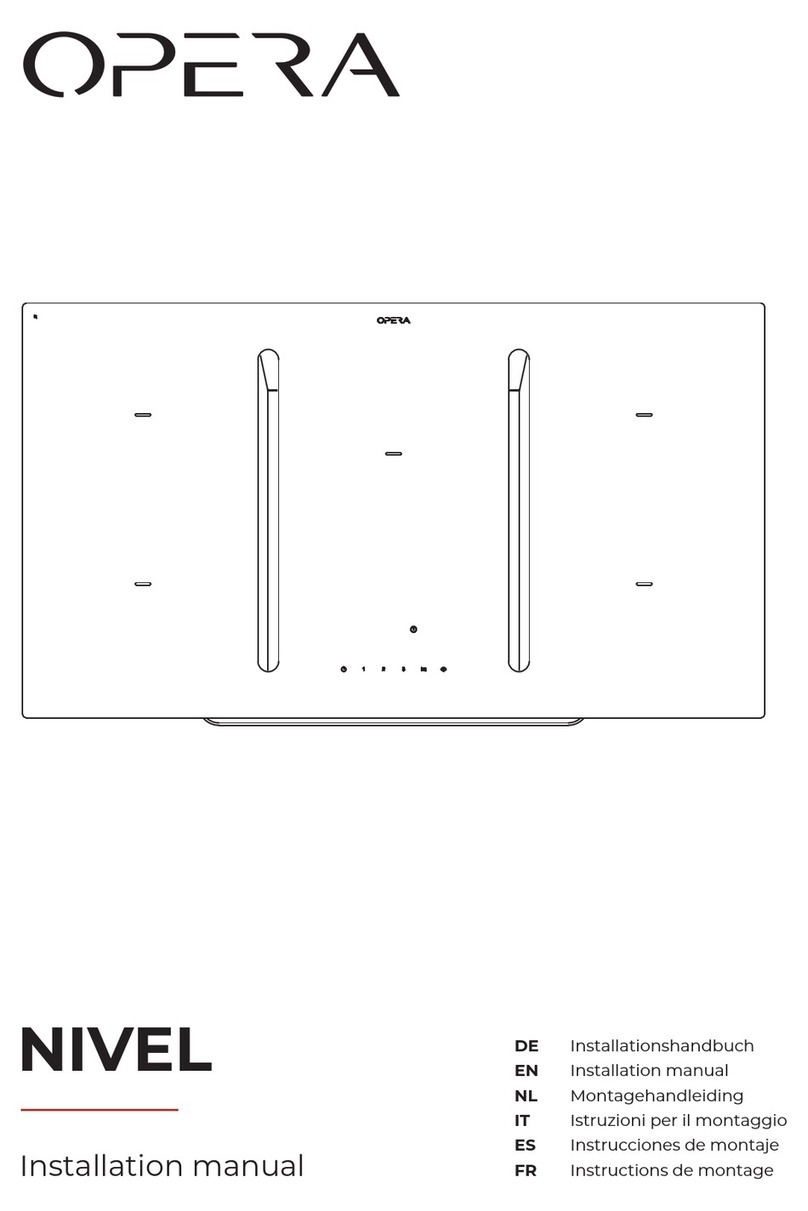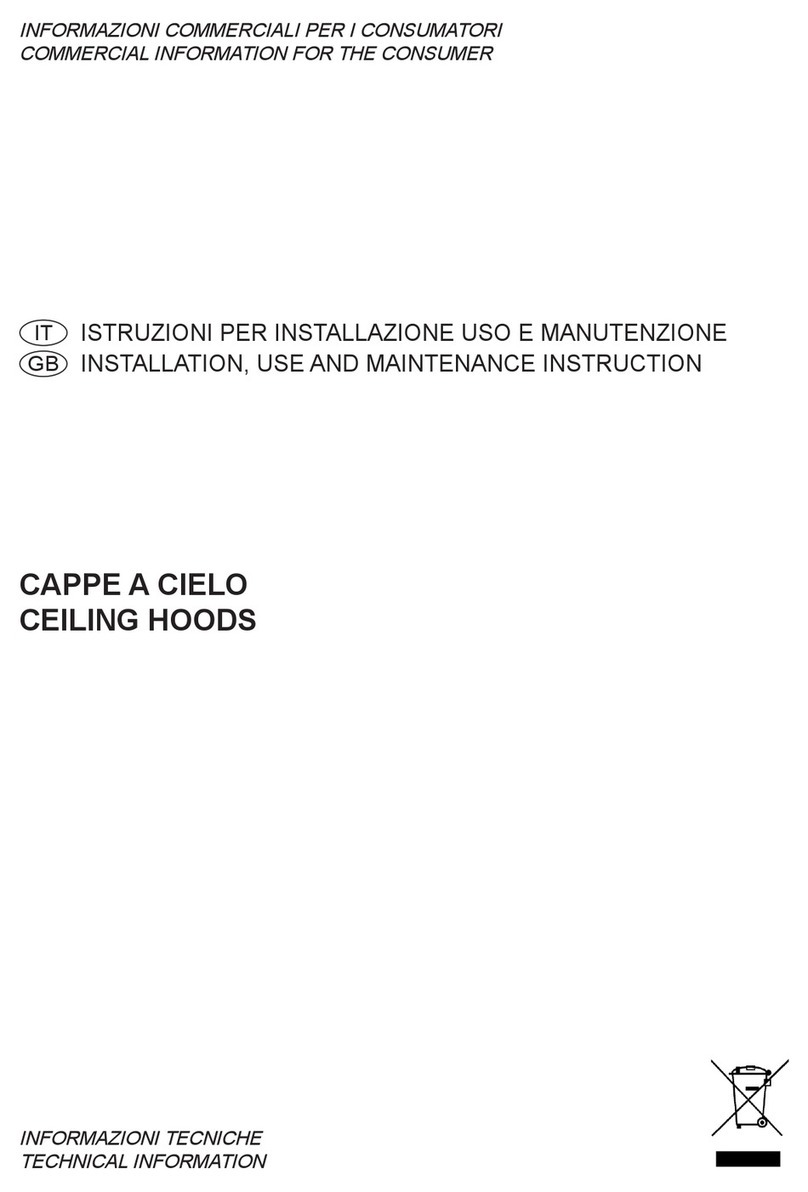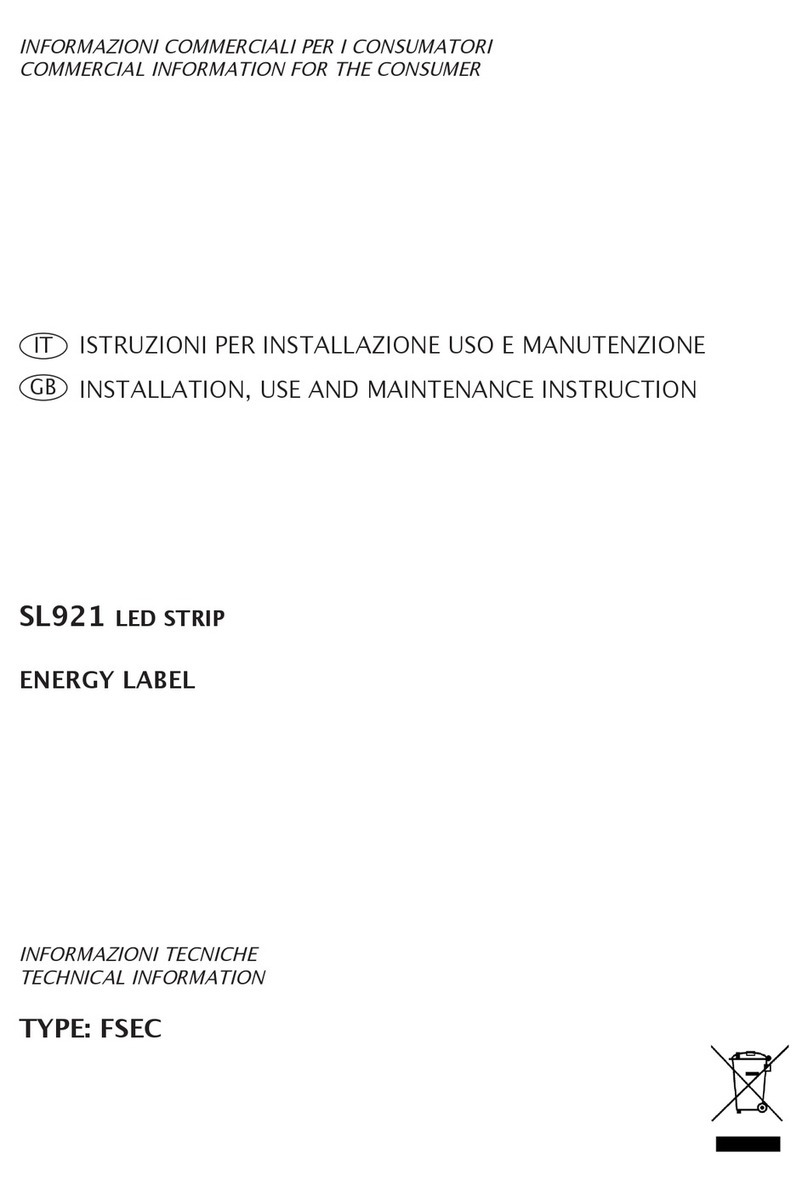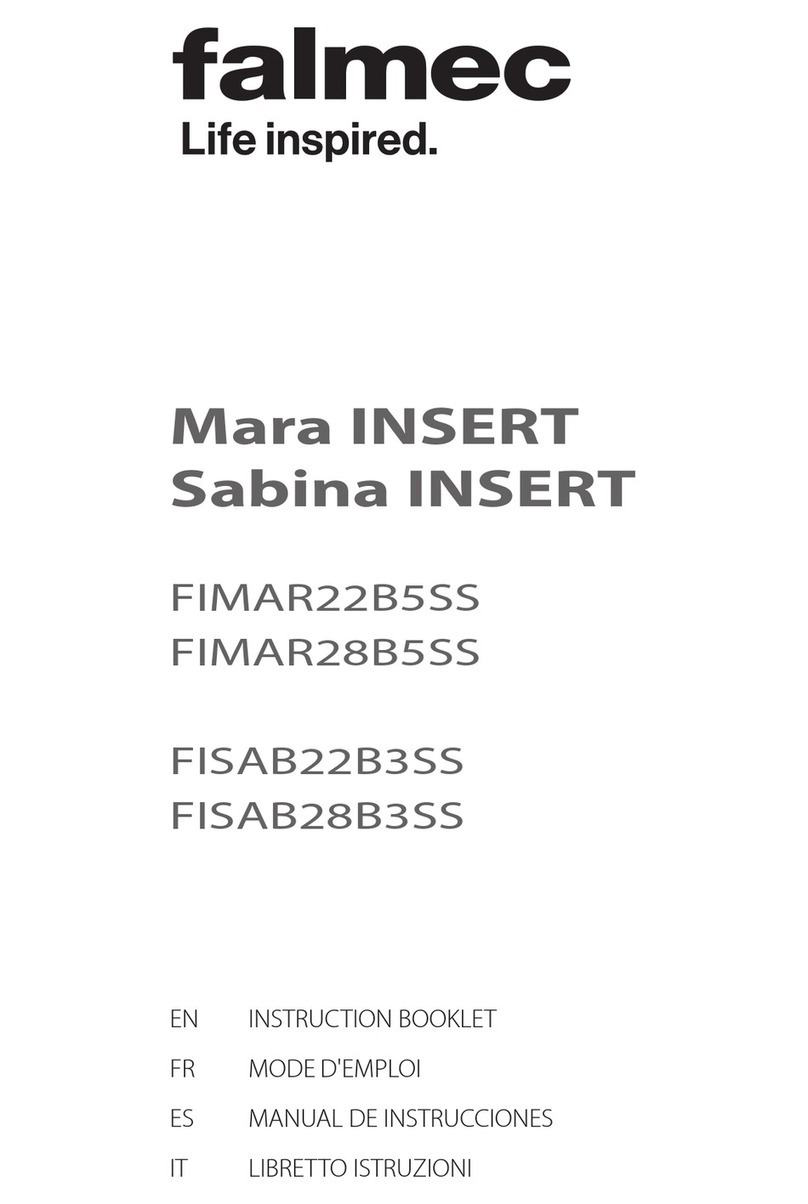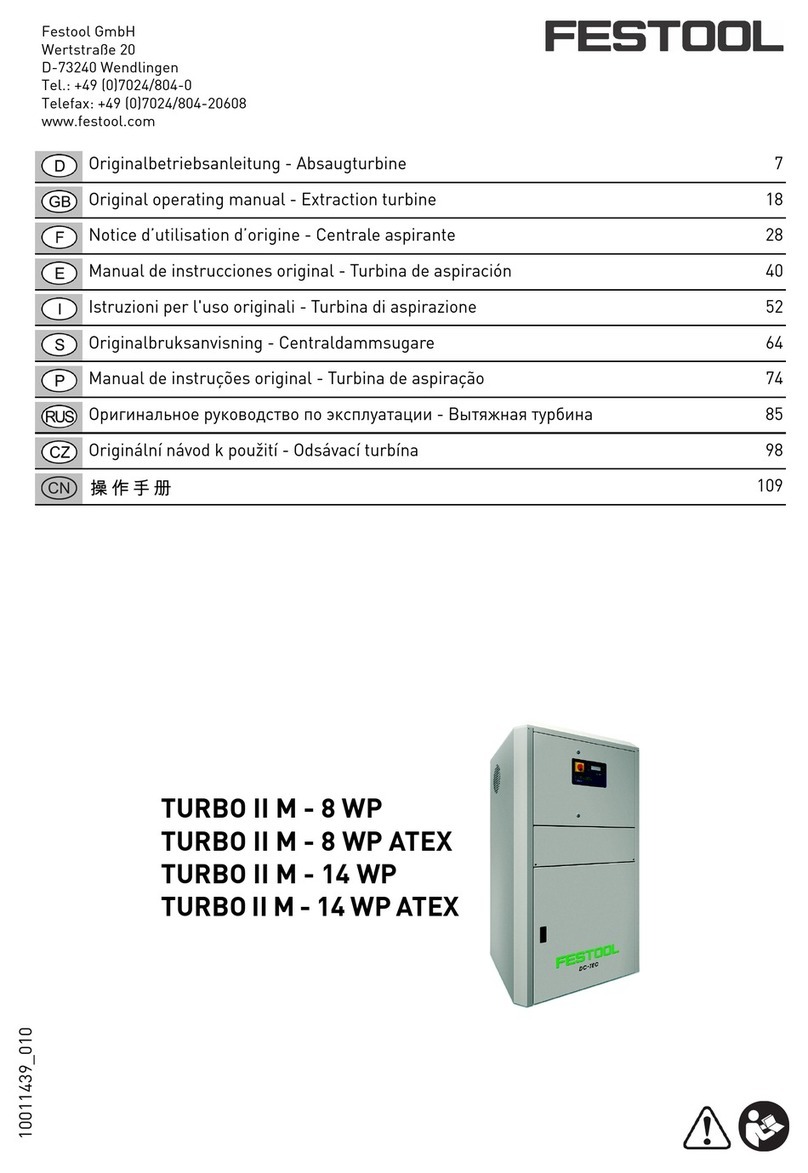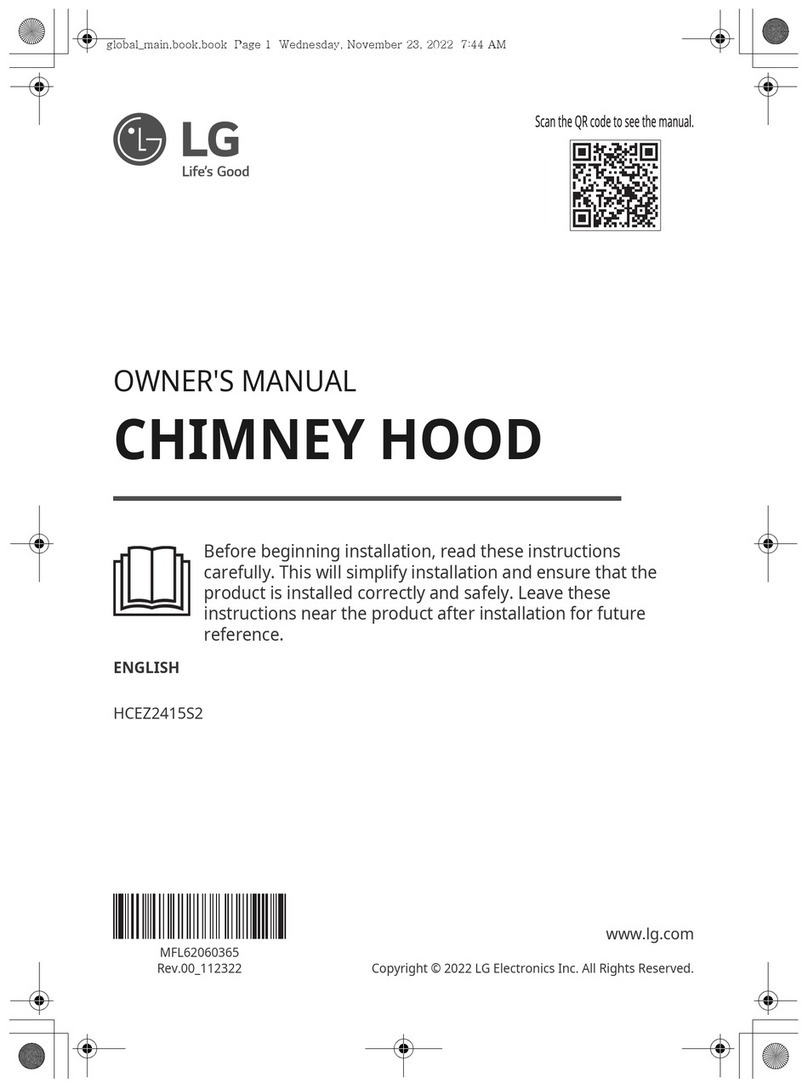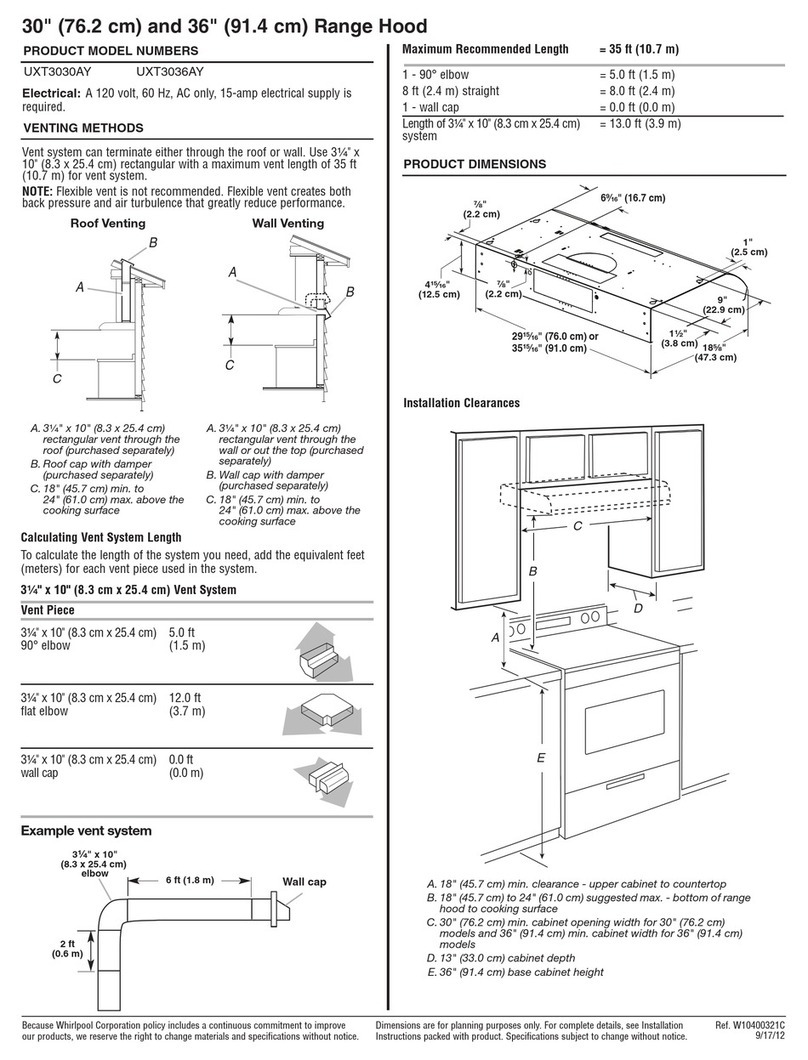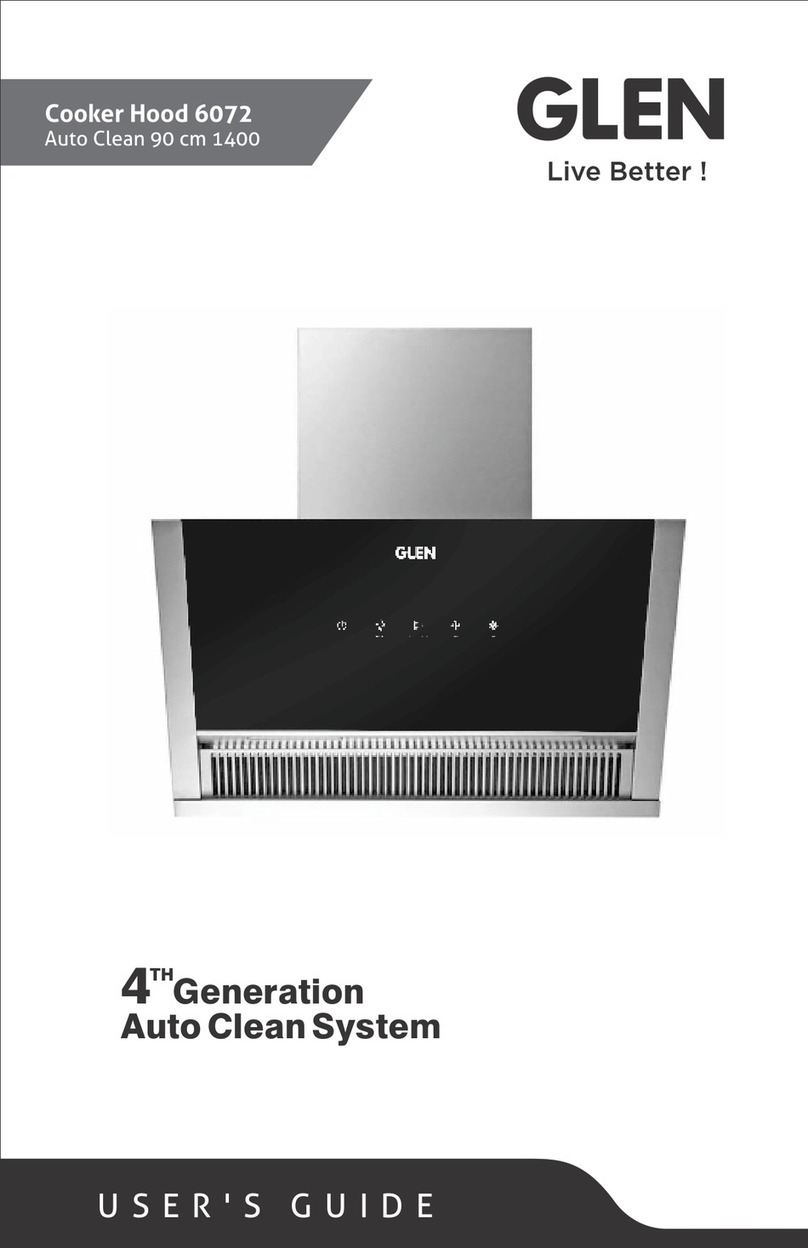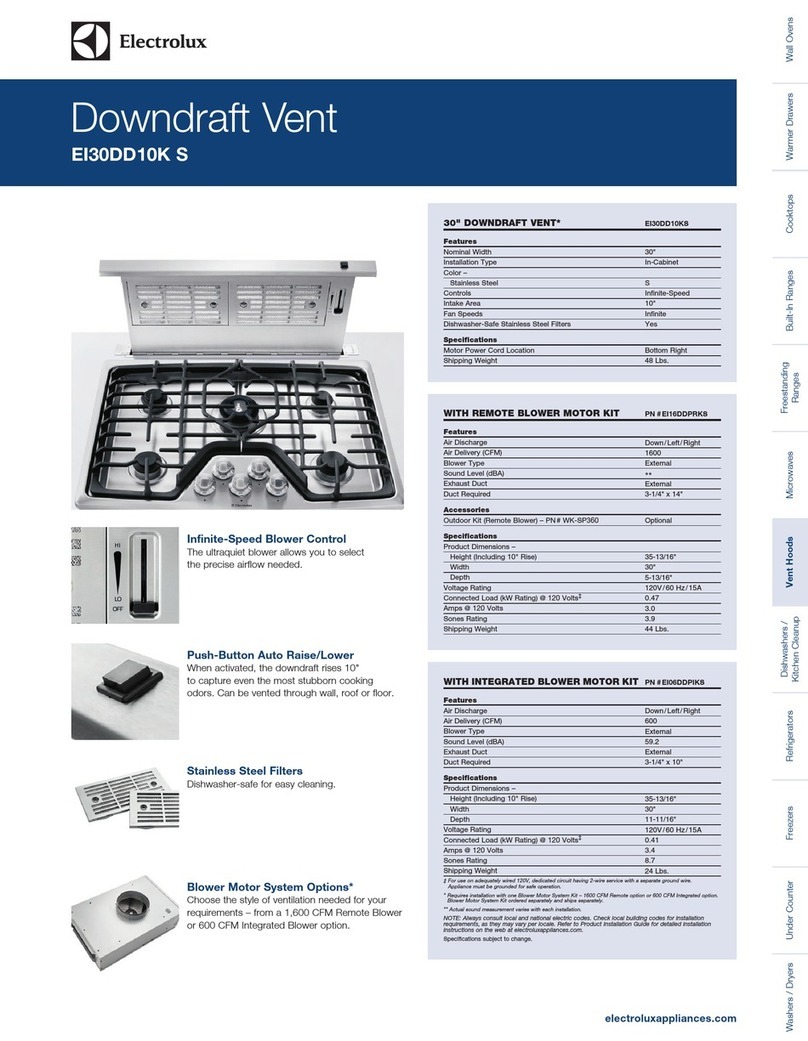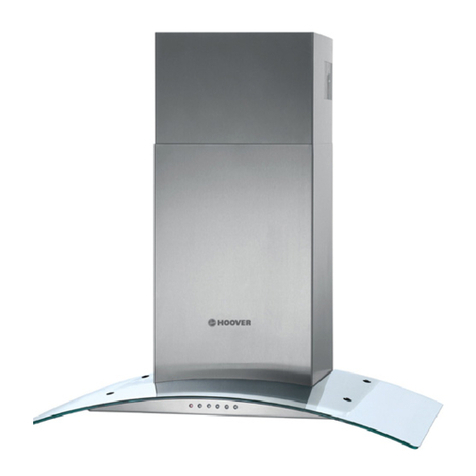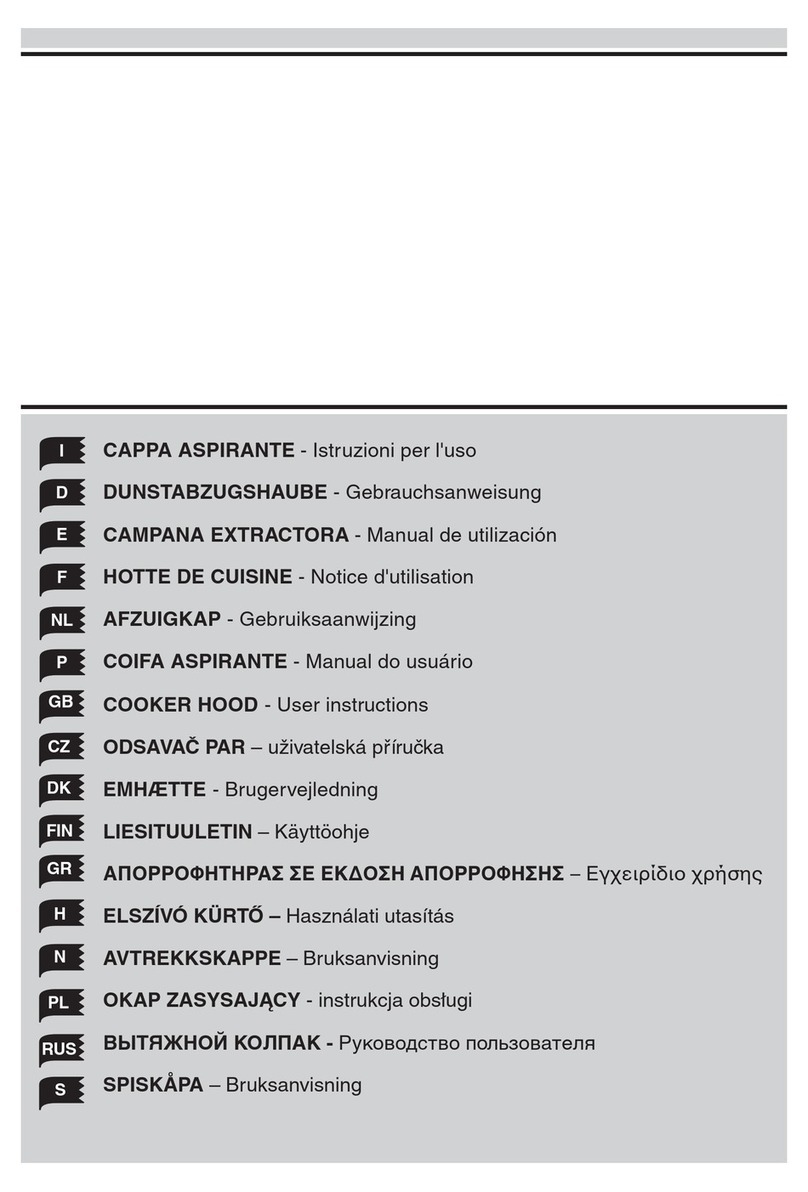Dake SIL24 Quick start guide

SIL24
ISTRUZIONI PER INSTALLAZIONE USO E MANUTENZIONE
INSTALLATION, USE AND MAINTENANCE INSTRUCTION
IT
GB
INFORMAZIONI COMMERCIALI PER I CONSUMATORI
COMMERCIAL INFORMATION FOR THE CONSUMER
INFORMAZIONI TECNICHE
TECHNICAL INFORMATION

2

1
3
2
34

4
5
67
Fig. 5.3
Fig. 5.2
Fig. 5.1
Fig. 6.2
Fig. 6.1
Fig. 7.6
Fig. 7.5
Fig. 7.4
Fig. 7.3
Fig. 7.2
Fig. 7.1

10
5
11
98
12 13

INDICE
Avvertenze
Versioni d’uso
Installazione
Funzionamento
Manutenzione
IT
6

- I bambini non devono giocare
con l’apparecchio.
- la pulizia e la manutenzione
non devono essere eseguite da
bambi ni senza supervisione.
- Se il cavo di alimentazione è
danneggiato, esso deve essere
sosti tuito da un cavo o da un as-
semblaggio speciale, disponibili
presso il costruttore o il suo ser-
vizio assistenza tecnica.
- Il locale deve disporre di ade-
guata ventilazione quando si
utilizza la cappa da cucina con-
temporaneamente con altri ap-
parecchi che impiegano gas o
altri combustibili (non si applica
agli apparecchi che si limitano a
scaricare nuovamente l’aria nel
locale);
- Esiste la possibilità di incendio
qualora le operazioni di pulizia
non vengano effettuate secondo
quanto indicato nelle istruzioni;
- Non preparare alimenti ambé
sotto la cappa da cucina.
ATTENZIONE: Le parti accessi-
bili possono scottare se utilizzate
in concomitanza con gli apparec-
chi di cottura.
AVVERTENZE
L’uscita aria dell’apparecchio, non
deve essere collegata ad un con-
dotto usato per lo scarico di altri
fumi quali impianti di riscaldamen-
to, scaldabagni, ecc..
Per l’emissione all’esterno dell’aria
rispettare le norme vigenti.
L’alimentazione per il motore della
centralina avviene tramite la cap-
pa posta in cucina.
Prima del collegamento elettrico
assicurarsi che i valori di tensione
dell’abitazione corrispondano con
quelli delle traghette dati elettrici
dell’apparecchio.
Prima di procedere a qualsiasi
tipo di operazione di pulizia o ma-
nutenzione assicurarsi che l’appa-
recchio sia scollegato dalla rete
elettrica.
Una buona manutenzione garanti-
sce un buon funzionamento ed un
buon rendimento nel tempo.
Tutti i modelli sono in classe I per-
tanto necessitano di collegamento
a terra.
- Questo apparecchio può essere
utilizzato da bambini di età pari o
superiore a 8 anni e da persone
con ridotte capacità siche, sen-
soriali o mentali o mancanza di
esperienza e conoscenza se sono
stati sottoposti a supervisione o
istruzione sull’uso dell’apparec-
chio in modo sicuro e comprendo-
no pericoli coinvolti.
7

VERSIONI D’USO
L’apparecchio è già predisposto sia per la versio-
ne ltrante sia per la versione aspirante.
* Nella versione ltrante (dis.1) l’aria ed i va-
pori convogliati dall’apparecchio, vengono depu-
rati sia da un ltro antigrasso sia da un ltro al
carbone attivo e rimessi in circolazione nell’am-
biente attraverso le grigliette laterali del camino.
Nell’uso in versione ltrante è necessario l’uso
di un deviatore aria (dis.1), che posto nella par-
te superiore del tubo permetta il riciclo dell’aria
nell’ambiente.
* Nella versione aspirante (dis. 2) i vapori ven-
gono convogliati direttamente all’esterno, tramite
un condotto di evacuazione che si collega con la
parte superiore della parete o del softto. L’utiliz-
zo del ltro al carbone non è necessario.
8
INSTALLAZIONE
Prima di procedere all’installazione, per evitare
danni dell’apparecchio, disinserire il ltro an-
tigrasso. La rimozione del ltro metallico anti-
grasso avviene operando sull’apposita maniglia
spingendola verso la parte posteriore della cappa
e facendo ruotare il ltro verso il basso sgancian-
dolo dalla sua sede (dis.4A).
Attenzione: l’installazione deve essere fatta
da almeno due persone.
Prima di procedere al ssaggio della cappa pre-
disporre l’alimentazione elettrica entro l’ingombro
del tubo decorativo ed un foro evacuazione aria
nel caso che la versione sia aspirante.
* Versione aspirante
Usando la piastra superiore (dis. 5.1) posizionan-
dola sul softto, effettuare 4 fori da 8 mm. in cor-
rispondenza delle asole. Nei fori eseguiti inserire
i tasselli in plastica (dis. 5.1-A) e ssare la piastra
sul softto con le viti (dis. 5.1-B). Successiva-
mente ssare la struttura inferiore (dis. 7.2) sulla
cappa facendo coincidere i fori della stessa con
le viti metriche saldate sul supporto ventilatore
(dis. 7.1). Inserire le relative rondelle ed i relativi
dadi in dotazione (dis. 7.2-A) avvitandoli con un
utensile idoneo.
Collegare il tubo per l’evacuazione dell’aria sul
boccaglio del gruppo motore ssandolo con una
fascetta commerciale.
Inserire la struttura superiore (dis. 7.3) sopra
quella inferiore regolandone la posizione in base
all’altezza precedentemente stabilita tenendo
presente l’altezza minima dal piano cottura. Con
le apposite viti (dis. 7.3-B) ssare le due strutture.
A questo punto inserire i due tubi telescopici
(dis. 7.4 e dis. 7.5) da sopra le strutture facendo-
li scendere no alla apposita sede della cappa.
Sollevare la cappa con la struttura ed i tubi inseriti
no a che le quattro molle (dis. 7.6-E) non si ag-
ganciano alle asole (dis. 7.3-C).
Una volta agganciate le due parti ssare tramite
le viti di sicurezza (dis. 6.2-A) i due componenti
(dis. 6.1 e dis. 6.2) collegando successivamente
il tubo della cappa al foro di evacuazione.
Effettuare il collegamento elettrico. (Solo per ver-
sione con display) sollevare il tubo inferiore no
a scoprire il cavo piattina che esce dal gruppo
aspirante e collegarlo al cavo piattina del display.

9
Riabbassare il tubo inferiore facendo attenzione
che entri correttamente nella sede della cappa
aspirante. Sollevare il tubo superiore no al soft-
to e inserire le due viti auto-lettanti (dis. 7.5-D).
* Versione ltrante
Usando la piastra superiore (dis. 5.1) posizionan-
dola sul softto, effettuare 4 fori da 8 mm. in cor-
rispondenza delle asole. Nei fori eseguiti inserire i
tasselli in plastica (dis. 5.1-A). Fissare il deettore
(dis. 5.2) alla staffa superiore (dis. 5.3) tramite le
quattro viti autoletanti in dotazione (dis. 5.3-A).
Fissare la piastra con il deettore montato a soft-
to con le viti (dis. 5.1-B). Successivamente ssare
la struttura inferiore (dis. 7.2) sulla cappa facendo
coincidere i fori della stessa con le viti metriche
saldate sul supporto ventilatore (dis. 7.1). Inserire
le relative rondelle ed i relativi dadi in dotazione
(dis. 7.2-A) avvitandoli con un’utensile idoneo.
Collegare il tubo per l’evacuazione dell’aria sul
boccaglio del gruppo motore ssandolo con una
fascetta commerciale. Inserire la struttura supe-
riore (dis. 7.3) sopra quella inferiore regolandone
la posizione in base all’altezza precedentemente
stabilita tenendo presente l’altezza minima dal pia-
no cottura. Con le apposite viti (dis. 7.3-B) ssare
le due strutture. A questo punto inserire i due tubi
telescopici (dis. 7.4 e dis. 7.5) da sopra le struttu-
re facendoli scendere no all’apposita sede del-
la cappa. Sollevare la cappa con la struttura ed i
tubi inseriti no a che le quattro molle (dis. 7.6-E)
non si aggancino alle asole (dis. 7.3-C). Una vol-
ta agganciate le due parti ssare tramite le viti di
sicurezza (dis. 6.2-A) i due compnenti (dis. 6.1 e
dis. 6.2) collegando successivamente il tubo della
cappa al foro inferiore del deettore.
Effettuare il collegamento elettrico.(Solo per ver-
sione con display) sollevare il tubo inferiore no
a scoprire il cavo piattina che esce dal gruppo
aspirante e collegarlo al cavo piattina del display.
Riabbassare il tubo inferiore facendo attenzione
che entri correttamente nella sede della cappa
aspirante. Sollevare il tubo superiore (dis. 7.5) no
al softto e inserire le due viti autolettanti (dis.
7.5-D).
Bloccaggio valvola
Attenzione! Prima di collegare il tubo essibile
uscita aria al motore, accertarsi che la valvola di
non ritorno posta sulla bocca del motore sia libe-
ra di roteare.
VERSIONE MOTORE REMOTO
Nel caso di motore esterno collegare il cavo del
gruppo motore nell’apposita morsettiera presente
nella scatola in plastica indicata in g. 13.
Fare attenzione nel rispettare i colori dei cavi du-
rante il collegamento elettrico.
FUNZIONAMENTO
Mod. SIL-Modulo versione lusso (dis. 8)
A: Interruttore on/off luce
B: Interruttore on (I velocità)/off motore
C: Interruttore II velocità
D: Interruttore III velocità
E: Interruttore IV velocità
F: Temporizzatore 10 minuti
Mod. SIL TC - versione Touch Control
(Dis.12)
A: INTERRUTTORE ON/OFF LUCI
B: RIDUZIONE VELOCITA’/ OFF MOTORE
C: INDICATORI VELOCITA’
D: ON MOTORE / AUMENTO VELOCITA’
E: TEMPORIZZATORE 10 min.
La pulsantiera Touch Control permette di im posta-
re la funzione desiderata sorando il relativo tasto.
Le spie luminose (C) posizionate al centro della
pulsantiera indicano la velocità di aspi razione im-
postata.
Nel caso di errato funzionamento della pulsantie-
ra, premere due volte il tasto di colore rosso visi-
bile all’interno della cappa dopo la rimozione del
ltro antigrasso.
Se il prodotto SILTC rimane privo di alimentazione
elettrica, al momento del ripristino delle funzioni ri-
chiede 15 secondi per l’auto diagnosi, nel frattem-
po potrebbe non funzio nare correttamente.

FUNZIONE LUCI DIMMERABILE
TALE FUNZIONE PREVEDE LA DIMMERA BILI-
TA’ DELLE LUCI DAL 20% FINO AL 100% TRA-
MITE LA PRESSIONE CONTINUATA DEL TASTO
LUCE DEL TELECOMANDO.
LE FUNZIONI SONO LE SEGUENTI:
- LUCE CAPPA SPENTA - PRESSIONE BREVE
DEL TASTO - ACCENZIONE LUCE AL 100%.
- LUCE ACCESA AL 100% - PRESSIONE BRE
VE DEL TASTO - SPEGNIMENTO LUCE.
- LUCE ACCESA AL 100% - PRESSIONE CON
TINUATA DEL TASTO - DIMINUZIONE DELLA
LUMINOSITÀ.
- RILASCIO DEL TASTO DURANTE LA DIMINU-
ZIONE O INCREMENTO - LA LUCE RIMANE
NELL’INTENSITÀ OTTENUTA.
- LUCE ACCESA DIMMERATA - NUOVA PRES
SIONE CONTINUATA DEL TASTO - INVERSIO-
NE LUMINOSITA’ RISPETTO ALLA PRECEDEN-
TE.
SETTAGGIO TEMPERATURA COLORE
Assicurarsi che le luci ed il ventilatore siano spenti.
Tenendo premuto il tasto TIMER , viene accesa
la luce nella temperatura colore impostata in pre
cedenza.
Premere e mantenere premuto il tasto Luce per
variare la temperatura colore.
Fintanto che il tasto viene mantenuto premuto, vie
ne variata la temperatura colore da calda a fredda,
basta lasciare il tasto Luce per seleziona re il co-
lore desiderato.
Uscire dalla funzione di selezione della tempera
tura colore premendo il tasto ON/OFF.
TEMPORIZZAZIONI
Con l’entrata in vigore dal 1° Gennaio 2015 dei
nuovi regolamenti della Commissione Europea
EU65 “Energy label” e EU66 “ Ecodesign”, ab
biamo reso conforme i prodotti in base ai requisiti
richiesti.
Tutti i modelli nelle versioni energy label dispon
gono di una elettronica, con funzioni di temporiz-
zazione delle velocità di aspirazione, superiore a
650m³/h.
In effetti i modelli con motore a bordo, con porta
ta massima superiore a 650m³/h, prevedono la
IVa velocità temporizzata dopo 5 minuti di funzio
namento, Trascorsi i tempi di cui sopra il motore
di aspirazione passa alla IIIa velocità in maniera
automatica.
I prodotti in versione external motor, vengono ab-
binati soltanto con motori remoti dove, come per
la versione con motore a bordo, vengono tempo-
rizzate le velocità con portate superiori a 650m³/h.
(Vedi istruzioni riportate nei motori re moti).
I motori remoti, che hanno una portata superio re a
650m³/h sia alla IVa che alla IIIa velocità, vengono
automaticamente temporizzate come segue: dalla
IVa velocità, dopo 6 minuti di funzio namento pas-
sa automaticamente alla II velocità.
Se il prodotto viene impostato alla IIIa velocità,
passa automaticamente alla II velocità dopo 7
minuti. Resta comunque possibile modicare le
velocità in uso.
Il prodotto in modalità stand-by ha un consumo
inferiore a 0.5W.
10

11
* Un’accurata manutenzione garantisce un buon
funzionamento ed un buon rendimento nel tem-
po.
* Una cura particolare va rivolta al pannello an-
tigrasso.
La rimozione del ltro avviene operando sull’ap-
posita maniglia spingendola verso la parte poste-
riore della cappa e facendo ruotare il ltro verso il
basso sganciandolo dalla sua sede (dis. 4).
Il ltro viene inserito nell’operazione inversa.
Dopo 30 ore di esercizio della cappa la pulsan-
tiera, segnalerà la saturazione del ltro, mediante
l’illuminazione di tutti i tasti.
Nel Mod. SILTC, Versione Touch Control, la sa-
trazione del ltro viene segnalata me diante lam-
peggio degli indicatori di veloci tà (Dis.12 C). Per
il reset, schiacciare il ta sto temporizzatore.
La pulizia del ltro antigrasso può essere esegui-
ta a mano o in lavastoviglie. La pulizia avviene in
rapporto all’uso, almeno una volta ogni due mesi.
* Nel caso d’uso dell’apparecchio in versione l-
trante, è necessario sostituire il ltro carbone atti-
vo (dis. 10A) periodicamente.
Il ltro di carbone si rimuove togliendo prima il
ltro antigrasso (dis. 9) e poi tirando l’apposita lin-
guetta in plastica del ltro carbone sgangiandolo
dalla sua sede (dis. 10).
Il ltro al carbone viene inserito nell’operazione
inversa. La sostituzione del ltro al carbone av-
viene in rapporto all’uso, almeno una volta ogni
sei mesi.
* Per la pulizia dell’apparecchio stesso viene
consigliato l’uso di acqua tiepida e detersivo neu-
tro, evitando l’uso di prodotti contenenti abrasivi.
Per la pulizia di apparecchi in acciaio viene con-
sigliato l’uso di prodotti specializzati, seguendo le
istruzioni indicate sul prodotto.
* Sostituzione della barra LED
Utilizzando un utensile appropriato, rimuovere la
barra LED dalla sua sede (vedi Fig. 11), scolle-
garla elettronicamente mediante l’apposito con-
nettore quindi sostituirla con una di pari caratte-
ristiche.
MANUTENZIONE

CONTENTS
Warnings
Uses
Installation
Working
Maintenance
GB
12

concerning use of the appliance
in a safe way and under stand
the hazards involved.
- Children shall not play with the
appliance.
- Cleaning and user maintenan-
ce shall not be made by children
without supervision.
- If the power cable is damaged,
it must be replaced by a cable
or a special assembly, available
from the manufacturer or its ser-
vice de partment technique.
- The room must have adequa-
te ventilation when using the
kitchen hood simultaneously with
other appliances that use gas or
other fuels (not yes applies to
appliances that simply release
the air back into the room);
- There is the possibility of re if
the cleaning operations are not
carried out as indicated in the in-
structions;
- Do not prepare ambéed food
under the kitchen hood.
ATTENTION: The accessible
parts can burn if used in conjun-
ction with the cooking applian-
ces.
WARNINGS
The air outlet of the appliance
must not be connected to a ue
which is used for exhausting other
fumes from appliances, such as a
central heating, boilers etc..
For the external exhausting of the
fumes, comply with the regula-
tions in force.
The motor of the peripheral
exhausting group is powered by
the coo ker-hood placed in the
kitchen.
Before connecting the cooker
hood to the mains supply, make
sure that the voltage indicated in
the rating plate corresponds to
the mains voltage in the home.
Before carrying out any sort of
maintenance or cleaning opera-
tion, make sure that the applian-
ce is disconnected from the elec-
trical mains.
An appropriate maintenance en-
sures a good working and a good
per formance in the long run.
All models are built in class I, the-
refore they must be earthed.
- This appliance can be used by
children aged from 8 years and
above and persons with reduced
physical, sensory or mental ca-
pabilities or lack of experience
and knowledge if they have been
given supervision or instruction
13

USES
The appliance is already arranged both for lte-
ring and for suction performances.
* In its ltering version (Fig. 1), the air and fu-
mes conveyed by the appliance are depured both
by a grease lter and by an active coal lter, and
put again into circulation through the side-grids of
the chimney. For this version an air deector pla-
ced on the superior part of the pipe and allowing
air-recycling is necessary (Fig. 1).
* In its sucking version (Fig. 2), fumes are di-
rectly conveyed outside, through an evacuation
duct connected with the superior part of the wall
or the ceiling. Both coal lter and air deector are
not necessary in this case.
14
INSTALLATION
* Before installing the appliance, in order not to
damage the appliance itself, the metal grease
lter should be removed. Such lter can be re-
moved by pushing the special lter handle toward
the back side of the cooker hood and turning it
downwards so to unfasten it from its slot (Fig. 3
- 4).
Attention: at least two people are needed to
perform the installation.
Before xing the hood, place the electric feeding
properly into the ornamental pipe and place a
hole for air evacuation in case of a sucking ver-
sion.
* Suction model
Place the upper plate (Fig.5.1) on the ceiling. Drill
4 holes, 8 mm each, just next to the slots.
Insert the plastic dowels into the holes (Fig.5.1-A)
and screw up the plate on the ceiling (Fig. 5.1-B).
Then fasten the lower structure (Fig. 7.2) on the
hood by making its holes and the metric-thread
screws welded on the fan support coincide (Fig.
7.1). Insert the washers and nuts provided (Fig.
7.2-A) and screw with an appropriate tool.
Connect the drainpipe to the power unit nozzle
and x securely with a hose clamp.
Insert the upper structure (Fig. 7.3) into the lowest
one and adjust its height as required by matching
it with the cooking top’s minimum height. Tighten
the two structures securely with the screws provi-
ded (Fig. 7.3-B).
Insert the two extension tubes (Fig. 7.4 & Fig.
7.5) from above the two structures by making
them come down to the appropriate hood seat.
Lift the hood together with the structure and the
extension tubes to make the four springs (Fig.
7.6-E) hook to the slots (Fig. 7.3-C). Then tighten
the two elements securely (Fig. 6.1 & Fig. 6.2)
with the safety screws (Fig. 6.2-A) and connect
the hood tube to the drain hole.
Make the electrical connections. (For versions
with display only) Lift the lower pipe until the ca-
ble strap coming out of the sucking unit is unco-
vered and connect it to the display cable strap.
Put down the lower pipe while paying attention it
is being properly introduced into the hood.
Lift the upper tube (Fig. 7.5) up to the ceiling and
insert the two self-tapping screws (Fig. 7.5-D).

15
* Filtering model
Place the upper plate (Fig.5.1) on the ceiling. Drill
4 holes, 8 mm each, just next to the slots. Insert
the plastic dowels into the holes (Fig.5.1-A). Fix
the bafe (Fig. 5.2) to the upper bracket (Fig.5.3)
with the four self-tapping screws provided (Fig.
5.3 A). Screw up the plate together with the baf-
e (Fig.5.1 B). Then fasten the lower structure
(Fig. 7.2) on the hood by making its holes and the
metric-thread screws welded on the fan support
coincide (Fig. 7.1). Insert the washers and nuts
provided (Fig. 7.2-A) and screw with an appro-
priate tool. Connect the drainpipe to the power
unit nozzle and x securely with a hose clamp. In-
sert the upper structure (Fig. 7.3) into the lowest
one and adjust its height as required by matching
it with the cooking top’s minimum height. Tighten
the two structures securely with the screws pro-
vided (Fig. 7.3-B). Insert the two extension tubes
(Fig. 7.4 & Fig. 7.5) from above the two structures
by making them come down to the appropriate
hood seat.
Lift the hood together with the structure and the
extension tubes to make the four springs (Fig.
7.6-E) hook to the slots (Fig. 7.3-C). Then tighten
the two elements securely (Fig. 6.1 & Fig. 6.2)
with the safety screws (Fig. 6.2-A) and connect
the hood tube to the bafe’s lower hole.
Make the electrical connections. (For versions
with display only) Lift the lower pipe until the ca-
ble strap coming out of the sucking unit is unco-
vered and connect it to the display cable strap.
Put down the lower pipe while paying attention it
is being properly introduced into the hood. Lift the
upper tube (Fig. 7.5) up to the ceiling and insert
the two self-tapping screws (Fig. 7.5-D).
Warning!
Before connecting the exible exhausting pipe to
the motor, make sure the stop valve, which is on
the air outlet of the motor, can swing.
EXTERNAL MOTOR VERSION:
Connect the the external motor’s cable to the ter-
minal board found inside the plastic box of the
wiring . Make sure to respect the colors of cables
when performing the electrical con nection (Fig.
13).
WORKING
Mod. SIL-Module luxury version (Fig. 8)
A: Light switch on/off
B: Motor switch on/off (1st rate level)
C: 2nd rate level switch
D: 3rd rate level switch
E: 4th rate level switch
F: 10 - minutes timer
Mod. SIL TC - Touch Control version (Dis. 12)
A: Light switch On/Off
B: Reduce speed
C: Luminous telltale
D: Incrase speed
E: 10 - minute timer
The touch control key allows the function de sired
by touching the relative key. The lumi nous telltales
(C) positioned at the center of the keyboard indica-
te the suction speed set.
In case of an active timer, the upper telltale (C)
ashes.
If the push button console malfunctions, re move
the grease lters and press the red but ton inside
the appliance twice.
If the electrical power supply to the product SILTC
is cut, 15 seconds are needed for self diagnostics
after the functions are restored.
In the meanwhile, its operation may be in correct.

DIMMABLE LIGHTS FUNCTION
THIS FUNCTION PROVIDES FOR LIGHTS DIM
MABILITY, RANGING FROM 20% TO 100% , BY
CONTINUOUSLY PRESSING THE LIGHT KEY
ON THE REMOTE CONTROL.
FUNCTIONS ARE THE FOLLOWING:
- HOOD LIGHT OFF - SHORTLY PRESS THE
KEY - LIGHT ON AT 100%.
- LIGHT ON AT 100% - SHORTLY PRESS THE
KEY - LIGHT OFF.
- LIGHT ON AT 100% - CONTINOUSLY PRESS
THE KEY - BRIGHTNESS REDUCTION.
- RELEASING THE KEY DURING REDUCTION
OR INCREASE - LIGHT KEEPS THE LUMI
NOUS INTENSITY REACHED.
- LIGHT ON - DIMMED - CONTINOUSLY PRESS
THE KEY - BRIGHTNESS IS INVERTED IF COM-
PARED TO THE PREVIOUS FUNCTION.
COLOUR TEMPERATURE SETTING
Make sure that the lights and the fan are off.
Holding down the TIMER key will turn on the light
at the previously set colour temperature.
Press and hold the Light key to change the colour
temperature.
As long as the key is kept pressed, the colour tem-
perature is changed from warm to cold, just leave
the Light key to select the desired colour.
Exit the colour temperature selection function by
pressing the ON/OFF key.
TIMING
As a result of the new EU65 “Energy label” and
EU66 “ Ecodesign” regulations issued by the Eu-
ropean Commission, which came into force as
from January 1st, 2015 , our products have been
adapted to comply with these new re quirements.
All of the models complying with the energy label
requirements, are equipped with new electroni-
cs including a timer device for suc tion speeds
control, when the air capacity ex ceeds 650m³/h.
Internal motor models, with maximum air capa-
city higher than 650m³/h, are equip ped with a
timer device that automatically switches the suc-
tion speed from 4th to 3rd speed, after 5 minutes
operation.
External motor models are equipped with re mote
motors that , as for internal motor ver sions, inclu-
de a timer device that switches down the suction
speed when it exceeds 650 mᵌ/h. (See External
Motors Instructions).
Remote motors, whose air capacity exce eds
650m³/h at both 4th and 3rd speed, will have the
following by default timer control functions: The
suction speed is automatical ly switched from 4th
to 2nd speed, after 6 minutes operation.
If the appliance is working at 3rd speed, it is auto-
matically switched to 2nd speed, after 7 minutes
operation. Operation speeds can also be chan-
ged during operation.
The energy consumption of the appliance in
stand - by mode is lower than 0.5W.
16

17
* An accurate maintenance guarantees good fun-
ctioning and long-lasting performance.
* Particular care is due to the grease lter panel.
It can be removed by pushing its special handle
toward the back-side of the cooker hood and tur-
ning the lter downwards so to unfasten it from
its slot (g. 4).
To insert the lter just perform the opposite ope-
ration.
After 30 hours working the push button control
panel will signal the saturation of the grease lter
by lighting all the buttons.
In the SILTC models (Touch Control Version) the
grease lter saturation is signalled by the ashing
of the two central push buttons (Fig. 12C). Press
the timer button to reset .
The grease lter needs cleaning by regular hand-
washing or in dishwasher every two months at
least or depending on its use.
* If the appliance is used in the ltering version,
the activated carbon lter (g. 10A) must be re-
placed periodically.
The carbon lter can be removed by rst remo-
ving the grease lter (as previously mentioned,
g. 9) and then releasing it as shown in g.10
from the 10B lter. Re-insert the coal lter by
operating in the opposite way. The coal lter ne-
eds replacing depending on the use, but however
every six months at least.
* To clean the appliance itself tepid water and
neutral detergent are recommended, while abra-
sive products should be avoided.
For steel appliances specialized detergents are
recommended (please follow the instructions in-
dicated o the product itself to obtain the desired
results).
Substitution of the LED bar:
Using an appropriate tool, remove the LED bar
from its seat (refer to g. 11), disconnect it elec
tronically using the appropriate connector then
substitute it with a LED bar with same charac-
teristics.
MAINTENANCE

18
Il simbolo sul prodotto o sulla confezione indica che il prodotto non deve essere considerato
come un normale riuto domestico, ma deve essere portato nel punto di raccolta appro-
priato per il riciclaggio di apparecchiature elettriche ed elettroniche. Provvedendo a smal-
tire questo prodotto in modo appropriato, si contribuisce a evitare potenziali conseguenze
negative per l’ambiente e per la salute, che potrebbero derivare da uno smaltimento ina-
deguato del prodotto. Per informazioni più dettagliate sul riciclaggio di questo prodotto,
contattare l’ufcio comunale, il servizio locale di smaltimento riuti o il negozio in cui è sta-
to acquistato il prodotto. Questo elettrodomestico è marcato conformemente alla Diretti-
va Europea 2012/19/EC sui riuti da apparecchiature elettriche ed elettroniche (WEEE).
IT
The symbol on the product or on its packaging indicates that this product may not be
treated as household waste. Instead it shall be handed over to the applicable collec-
tion point for the recycling of electrical and electronic equipment. By ensuring this pro-
duct is disposed of correctly, you will help prevent potential negative consequences for
the environment and human health, which could otherwise be caused by inappropriate
waste handling of this product. For more detailed information about recycling of this pro-
duct, please contact your local city ofce, your household waste disposal service or the
shop where you purchased the product. This appliance is marked according to the Eu-
ropean directive 2012/19/EC on waste electrical and electronic equipment (WEEE).
GB

19

90007000024 - EM 01/21
Table of contents
Languages:
Other Dake Ventilation Hood manuals
